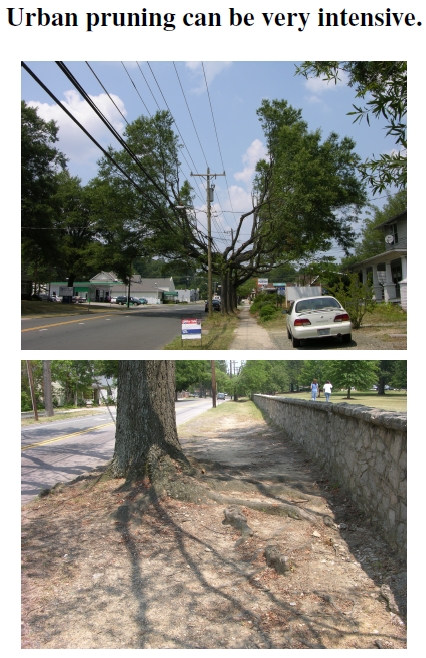3.11 Urban Pruning
Figure 3.11: A tree that has undergone extensive pruning, sacrificing shade and beauty, for the sake of protecting power lines during hurricanes. Another photo shows growing damage to a curb and stone wall, not to mention challenges to pedestrians. What good are these urban trees?
We all understand the differences between a tree growing peacefully and unabtrusively in a forest and a tree growing in the city near sidewalks and foundations, on top of sewer lines, and underneath power lines. Here in Figure 3.11 I picture two examples of problematic urban trees. During the summer of 2007, some serious tree pruning took place on Durham’s Broad Street before nearby residents complained. City leaders reexamined the work, finding that it wasn’t taking place according to stated principles of urban forestry.
No doubt about it though, serious interference issues exist between the trees and the overhead power lines in the top photo. In its unpruned state, if a hurricane happened to come along, the tree would take all the power and phone lines down with high repair costs. Even just a falling, rotted branch would cost serious money, not just to clean up the branches and repair a vehicle, but also repair the power line and increase electricity costs. Not only do these pruning costs get passed down to taxpayers, but if the power goes out consumers bear the cost of replacing all the spoiled food in their refrigerators. The bottom photo shows the potential destruction of roots located near roads and walls; we’ve all seen examples of sidewalks buckled by growing trees. In the wrong places, urban trees require pruning and maintenance, and these pictures show the result.
Human costs also factor in. The National Institute for Occupational Health and Safety reports that between 1980 and 1989, at least 207 deaths were associated with tree trimming, including 68 deaths by electrocutions (contact with power lines) and 52 deaths by falls.[54] Planting more trees beneath power lines means more required trimming, and, inevitably, more fatalities. This 1980s fatality rate means, roughly, that a city of a million people should expect one treetrimming fatality per decade. Accidents happen, and urban citizens must recognize the complicated balance between city services and trees beyond just carbon and energy. The right tree in the right place needs less maintenance, providing benefits at lower cost.
With these pictures in mind, I roughly divide the remainder of this chapter into two connected parts concerning urban trees, the first concentrating on a carbon budget and the second focused on an energy budget. My carbon budget examination makes little mention of energy and energy sources; rather, it mostly looks at the carbon costs of maintaining urban trees. The second part, urban trees’ energy budget, looks at the potential energy savings from well-placed trees, as well as the potential for trees to serve as an energy source.
———————————–
[54]An example of a case report regarding a tree-trimming death, from www.cdc.gov/niosh/92-106.html: “On October 9, 1990, a 27-year-old tree trimmer (the victim) was working as part of a four-man crew to remove dead trees from a private home in a semi-rural area. The crew had been on the site for 2 days and had removed four large trees. They were working on the fifth tree and had cut off all of the tree limbs. Even though each tree was checked for rot by tapping on the trunk, the crew was unaware of the presence of wood wasps in the upper trunk–a sign of rot. At midmorning, the victim (wearing a saddle belt attached to a cloth lanyard) climbed the tree to cut it away in sections. While ascending the tree, the victim reportedly realized that the tree was more damaged than expected, stopped climbing at approximately 35 feet, and tied off at that height. The rotted tree had a list of approximately 10 to 15 degrees, and as the top section was cut away, the tree bent with it. As the tree sprang back to its original position, the backlash was strong enough to fracture the trunk 6 feet below the cut area where the victim had tied his lanyard. The tree trimmer died when he fell to the ground with the tree section, which landed on top of him.”
